polar fox
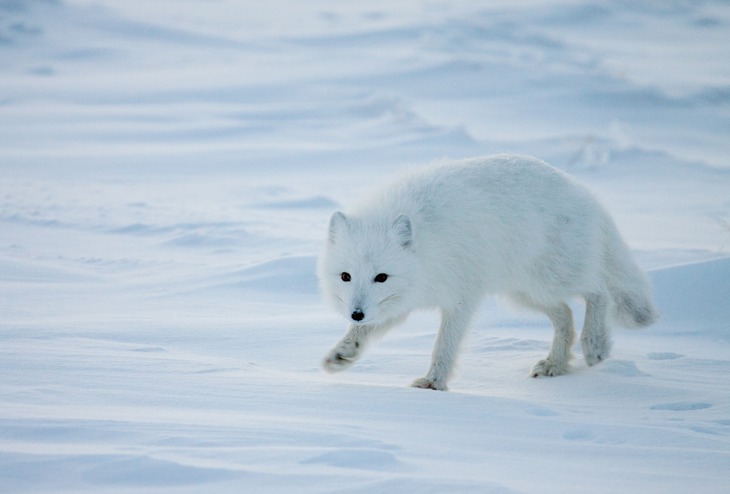 The ordinary polar fox, or polar fox , is more rare the Arctic fox (Latin of Vulpes lagopus, [than syn. Alopex lagopus] from other - Greek ἀλώπηξ "fox" and λᾰγώπους "zaytsenogy") — a predatory mammal of family of canids, the only representative of a genus of polar foxes (Alopex). The small predatory animal reminding a fox. Length of a body is 50 — 75 cm, a tail — 25 — 30 cm, height in withers — 20 — 30 cm. The average body weight of a male — 3,5 kg, maximum — up to 9 kg, a female — 3 kg [2][3]. Unlike a fox, a body at a polar fox stocky, the muzzle shortened; ears are rounded off, poorly act from winter wool (it protects them from a frostbite). The name of a look — lagopus — in translation from Greek "a hare paw": soles of paws at polar foxes are covered with a hard hair.
The ordinary polar fox, or polar fox , is more rare the Arctic fox (Latin of Vulpes lagopus, [than syn. Alopex lagopus] from other - Greek ἀλώπηξ "fox" and λᾰγώπους "zaytsenogy") — a predatory mammal of family of canids, the only representative of a genus of polar foxes (Alopex). The small predatory animal reminding a fox. Length of a body is 50 — 75 cm, a tail — 25 — 30 cm, height in withers — 20 — 30 cm. The average body weight of a male — 3,5 kg, maximum — up to 9 kg, a female — 3 kg [2][3]. Unlike a fox, a body at a polar fox stocky, the muzzle shortened; ears are rounded off, poorly act from winter wool (it protects them from a frostbite). The name of a look — lagopus — in translation from Greek "a hare paw": soles of paws at polar foxes are covered with a hard hair.
The only representative of family of canids to whom the expressed seasonal dimorphism of coloring is inherent. On coloring distinguish usual white (in the winter — purely - white, in the summer — dirty and brown) and a blue polar fox. At the last a winter dress dark: from sand and light coffee to dark gray with a bluish reflection and even brown with silver. Blue polar foxes meet in all populations, but on the continent they are rare, and on some islands, on the contrary, prevail.
The spring molt of polar foxes, as a rule, begins in March — April and lasts up to 4 months. Autumn — from September to December. The best fur at polar foxes happens in January — February.
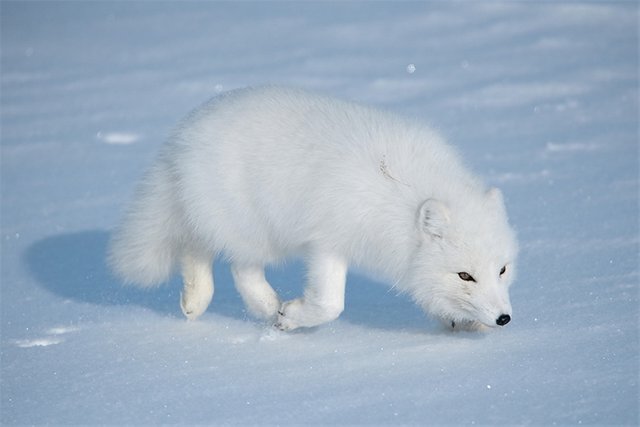
Distribution and subspecies
The polar fox is widespread beyond Arctic Circle, on the coast and the islands of the Arctic Ocean, in tundra and forest-tundra zones. In Russia it is the typical representative of fauna of the continental tundra and forest-tundra. During winter movements the polar fox comes to the South of Finland, the southern part of Baikal region, lower reaches of Amur.
Forms 10 subspecies. So poorly expressed geographical variability is caused by big mobility of a polar fox and continuous mixture of populations.
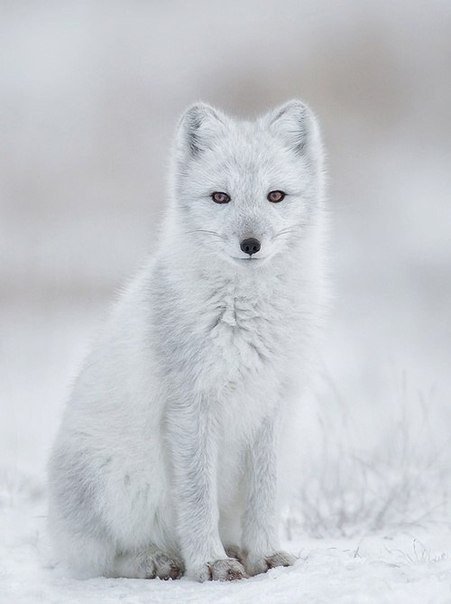
Way of life and food of a polar fox
As typical habitats of a polar fox serves the open tundra with a hilly relief. On sandy hills and coastal terraces he digs holes, difficult underground labyrinths with a set of entrances. The polar fox digs a hole in soft soil in an environment of stones (they protect an entrance from unearthing by large predators) to permafrost level, deepening it as soil thaws. Holes never happen further half a kilometer from water. Suitable places for construction of holes in the tundra aren't enough therefore polar foxes use them for years, sometimes for 15 — 20 years in a row, and with breaks — hundreds and even thousands of years so some hills are entirely pitted. Less often polar foxes lodge among scatterings of stones or in fin heaps on the coast. In the winter the polar fox quite often is content with a simple den in snow.
The polar fox is omnivorous, about 125 animal species and 25 species of plants are a part of his forage. However its basis is made by small rodents, especially lemmings and also birds. Eats both the fish cast ashore, and got and also vegetable food: berries (bilberry, cloudberries), herbs, seaweed (sea cabbage). Sometimes attacks even the calfs of a reindeer who have beaten off herd. Doesn't refuse drop. On the coast the polar fox often accompanies polar bears, and he gets a part of meat of the killed seals. At last, he eats the animals who have got to traps, without doing an exception even for other polar foxes. Reserves in a den surplus of food for the winter in the summer.
At a polar fox hearing and sense of smell are well developed; slightly more weakly — sight. The voice represents the yelping bark.
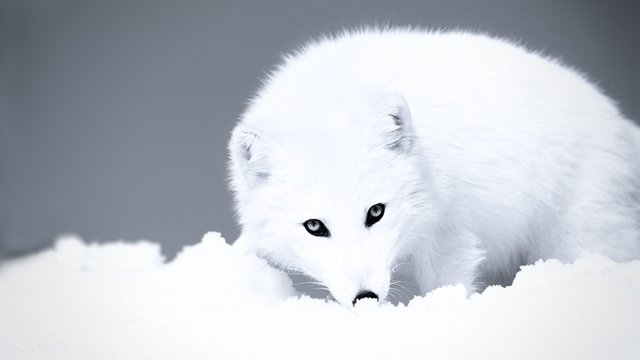
Social structure and reproduction
As a rule, these animals are monogamous though sometimes (on the Commander Islands) polygamy cases are observed. The typical family of polar foxes consists of a male, a female, young females from the previous dung and cubs of the current year. Usually families live separately, however can lodge also colonies on 2 — 3 families. The land area of dwelling of family of polar foxes fluctuates from 2 to 30 km ². The polar fox carries out a considerable part of year, wandering in search of food. By the time of reproduction polar foxes come back to those places from where otkochevyvat in the fall — in the winter, and or occupy ready holes, or dig out new.
Techka happens in March — April and is followed by fights of males. Pregnancy of 49 — 57 days; in a dung of 7 — 12 and more cubs (the largest number among predators). The male together with a female cares for posterity. White foxes are born covered with dark, smoky brown fur, blue — almost brown. Eyes open for 9 — 18 day. At the age of half a year young polar foxes reach the size of parents. Can breed the next year though full development is reached only for the second year (very seldom on the first).
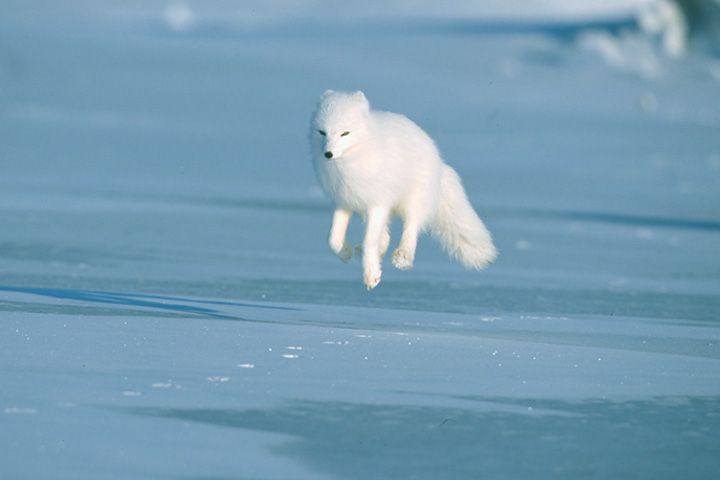.jpg)
The factors influencing number
The number of polar foxes is subject to sharp fluctuations depending on abundance of forages, (especially lemmings). The great influence on the number of local populations is exerted by migrations. Every fall the set of the animals inhabiting the tundra goes along sea coasts and river valleys to the South. In the spring polar foxes gradually come back. In lean years these resettlements accept especially mass character. Many of the wandering animals perish.
The polar fox is pursued by larger predators. He is attacked by foxes, gluttons and wolves; there are enough young polar foxes sea eagles and snowy owls. The young growth often perishes from helminthic invasions, adults — from a dikovaniye (VETZh), are more rare — from rage.
Life expectancy of polar foxes in the native habitat — 6 — 10 years.
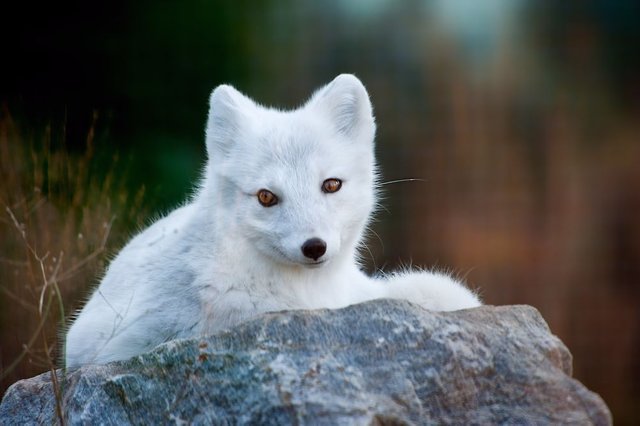
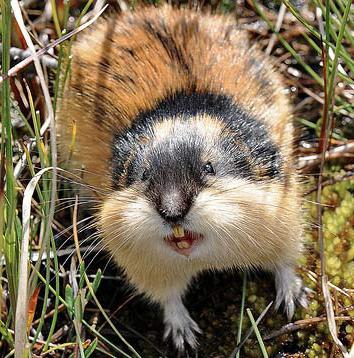
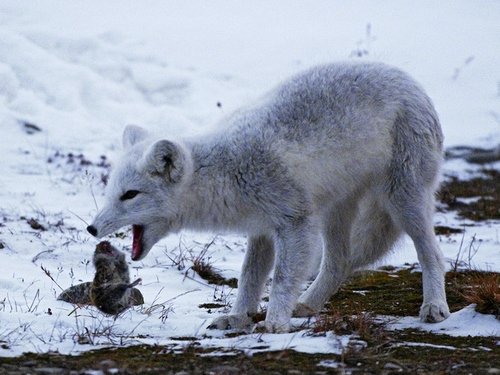
Economic value
The polar fox — an important fur-bearing animal, is a source of valuable fur; in the north makes a basis of fur trade. Skins of a blue polar fox who is also subject to cellular cultivation are especially appreciated. On the islands surrounded with the nonfreezing sea semi-free cultivation is adjusted — polar foxes live on freedom and on a signal resort on a forage to special traps. Farms for cultivation of polar foxes are available in northern and middle latitudes of America, Europe and Asia.